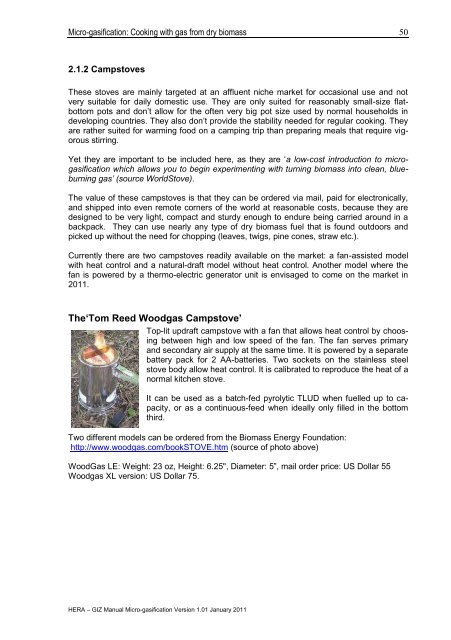Micro-gasification: Cooking with gas from biomass - Amper
Micro-gasification: Cooking with gas from biomass - Amper
Micro-gasification: Cooking with gas from biomass - Amper
Create successful ePaper yourself
Turn your PDF publications into a flip-book with our unique Google optimized e-Paper software.
<strong>Micro</strong>-<strong><strong>gas</strong>ification</strong>: <strong>Cooking</strong> <strong>with</strong> <strong>gas</strong> <strong>from</strong> dry <strong>biomass</strong><br />
2.1.2 Campstoves<br />
These stoves are mainly targeted at an affluent niche market for occasional use and not<br />
very suitable for daily domestic use. They are only suited for reasonably small-size flatbottom<br />
pots and don‘t allow for the often very big pot size used by normal households in<br />
developing countries. They also don‘t provide the stability needed for regular cooking. They<br />
are rather suited for warming food on a camping trip than preparing meals that require vigorous<br />
stirring.<br />
Yet they are important to be included here, as they are ‗a low-cost introduction to micro<strong><strong>gas</strong>ification</strong><br />
which allows you to begin experimenting <strong>with</strong> turning <strong>biomass</strong> into clean, blueburning<br />
<strong>gas</strong>’ (source WorldStove).<br />
The value of these campstoves is that they can be ordered via mail, paid for electronically,<br />
and shipped into even remote corners of the world at reasonable costs, because they are<br />
designed to be very light, compact and sturdy enough to endure being carried around in a<br />
backpack. They can use nearly any type of dry <strong>biomass</strong> fuel that is found outdoors and<br />
picked up <strong>with</strong>out the need for chopping (leaves, twigs, pine cones, straw etc.).<br />
Currently there are two campstoves readily available on the market: a fan-assisted model<br />
<strong>with</strong> heat control and a natural-draft model <strong>with</strong>out heat control. Another model where the<br />
fan is powered by a thermo-electric generator unit is envisaged to come on the market in<br />
2011.<br />
The„Tom Reed Wood<strong>gas</strong> Campstove‟<br />
Top-lit updraft campstove <strong>with</strong> a fan that allows heat control by choosing<br />
between high and low speed of the fan. The fan serves primary<br />
and secondary air supply at the same time. It is powered by a separate<br />
battery pack for 2 AA-batteries. Two sockets on the stainless steel<br />
stove body allow heat control. It is calibrated to reproduce the heat of a<br />
normal kitchen stove.<br />
It can be used as a batch-fed pyrolytic TLUD when fuelled up to capacity,<br />
or as a continuous-feed when ideally only filled in the bottom<br />
third.<br />
Two different models can be ordered <strong>from</strong> the Biomass Energy Foundation:<br />
http://www.wood<strong>gas</strong>.com/bookSTOVE.htm (source of photo above)<br />
WoodGas LE: Weight: 23 oz, Height: 6.25", Diameter: 5‖, mail order price: US Dollar 55<br />
Wood<strong>gas</strong> XL version: US Dollar 75.<br />
HERA – GIZ Manual <strong>Micro</strong>-<strong><strong>gas</strong>ification</strong> Version 1.01 January 2011<br />
50
















